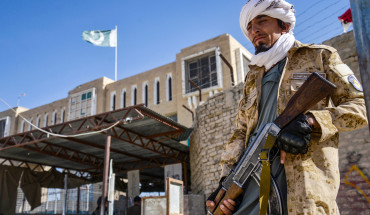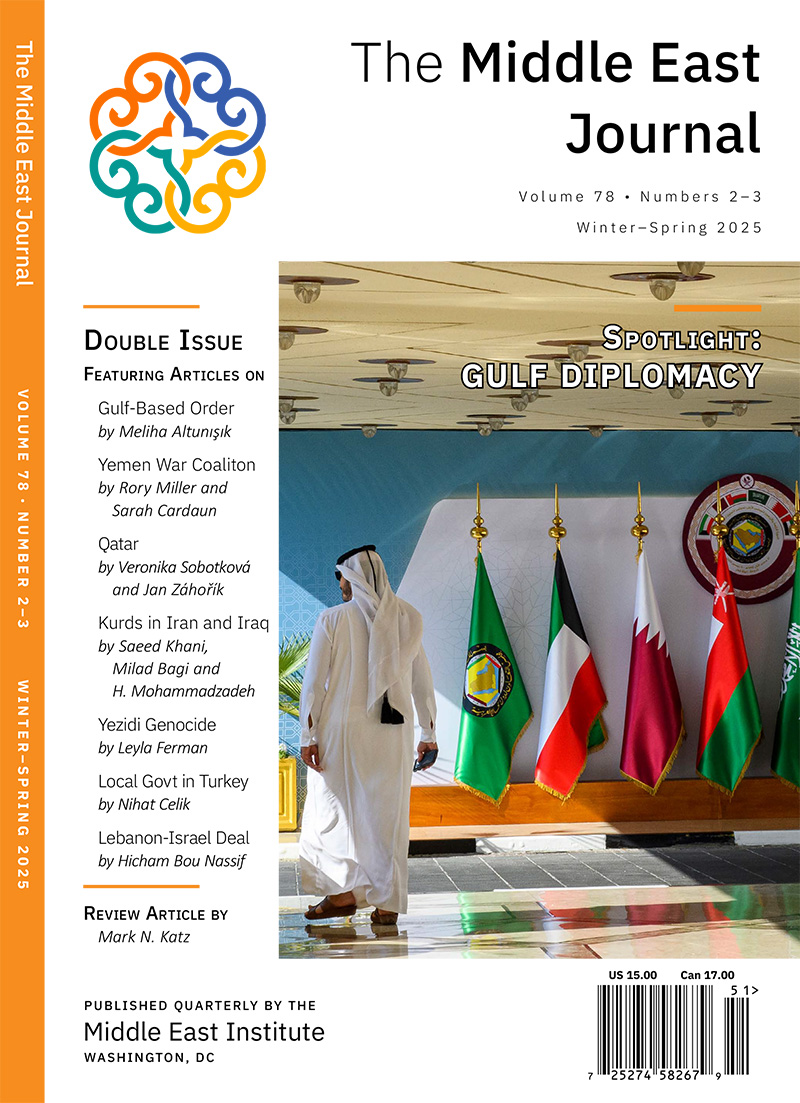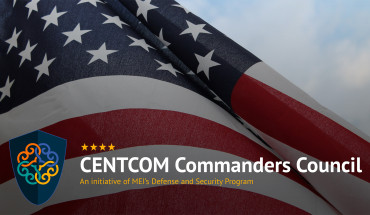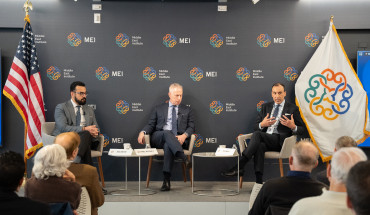
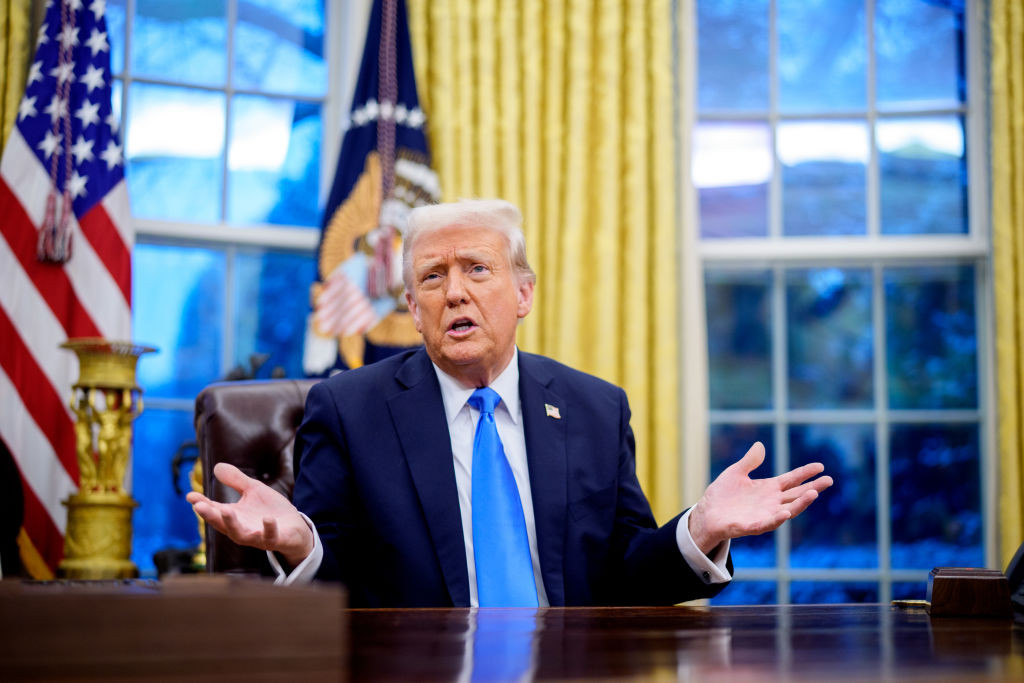
President Donald J. Trump’s trip to the Middle East on May 13-16 comes on the heels of more than three months of whirlwind activity in US foreign policy where the region has been a higher priority than it was in the early months of the previous US administration. The US president has gained attention by proposing some provocative ideas and his team has made some signs of progress in talks with Iran, but thus far the second Trump administration has produced very few tangible advances for stability, prosperity, and progress in the Middle East.
The following report assesses the US government’s actions over the past three months from late January to late April 2025. It represents the independent analytical judgments of one analyst at the Middle East Institute based on his policy research and research support from key colleagues, as well as the independent feedback from colleagues in a peer review process. It is part of a regular, quarterly assessment that includes a report card with grades on five key policy areas based on long-standing US national security interests in the Middle East and priorities set by the current US administration.
I. Executive Summary
-
President Donald J. Trump’s trip to the Middle East next week comes on the heels of more than three months of whirlwind activity in US foreign policy where the region has been a higher priority than it was in the early months of the previous US administration.
-
The second Trump administration thus far has produced very few tangible advances for stability, prosperity, and progress in the Middle East. The administration’s approach on Iran has created some hope for a new nuclear deal, but it has not seen any major gains toward a resolution of the Israeli-Palestinian conflict.
-
Trump 2.0’s overall foreign policy has prioritized unprecedented economic warfare, harsh immigration policies, major cuts in US national security institutions, and unconventional strategic communications with many mixed messages. The zigzagging style of Trump’s unorthodox approach comes at a time of extreme uncertainty in the Middle East. At this early stage, the United States is navigating uncharted waters without a normal compass or a clear map.
-
The US president gained attention by proposing some provocative ideas, like the “Gaza Riviera” notion, and he sought investments and economic deals with key regional economic powers. But Trump has yet to come close to many of the promises and assertions he made while campaigning for president last year, including his goal of expanding the 2020 Abraham Accords.
-
The second Trump administration also launched military strikes against the Houthis in Yemen and offered unrestricted support to Israel’s military actions against adversaries in Gaza, Lebanon, and Syria. Trump deployed his diplomatic team to the region in efforts aimed at achieving a cease-fire and hostage release deal between Israel and Hamas, implementing the November 2024 Israel-Hezbollah cease-fire agreement, and pursuing a new Iran nuclear deal.
-
This report is part of a regular, quarterly assessment that includes a report card with grades on five key policy areas based on long-standing US national security interests in the Middle East and priorities set by the current US administration. Some of the key long-standing interests for America in this part of the world include energy security, support for US partners, regional stability, freedom of navigation, prevention of war, counterterrorism, containment of Iran, and non-proliferation.
-
The following report assesses the US government’s actions over the past three months from late January to late April 2025. It represents the independent analytical judgments of one analyst at the Middle East Institute based on his policy research and research support from key colleagues, as well as the independent feedback from colleagues in a peer review process.
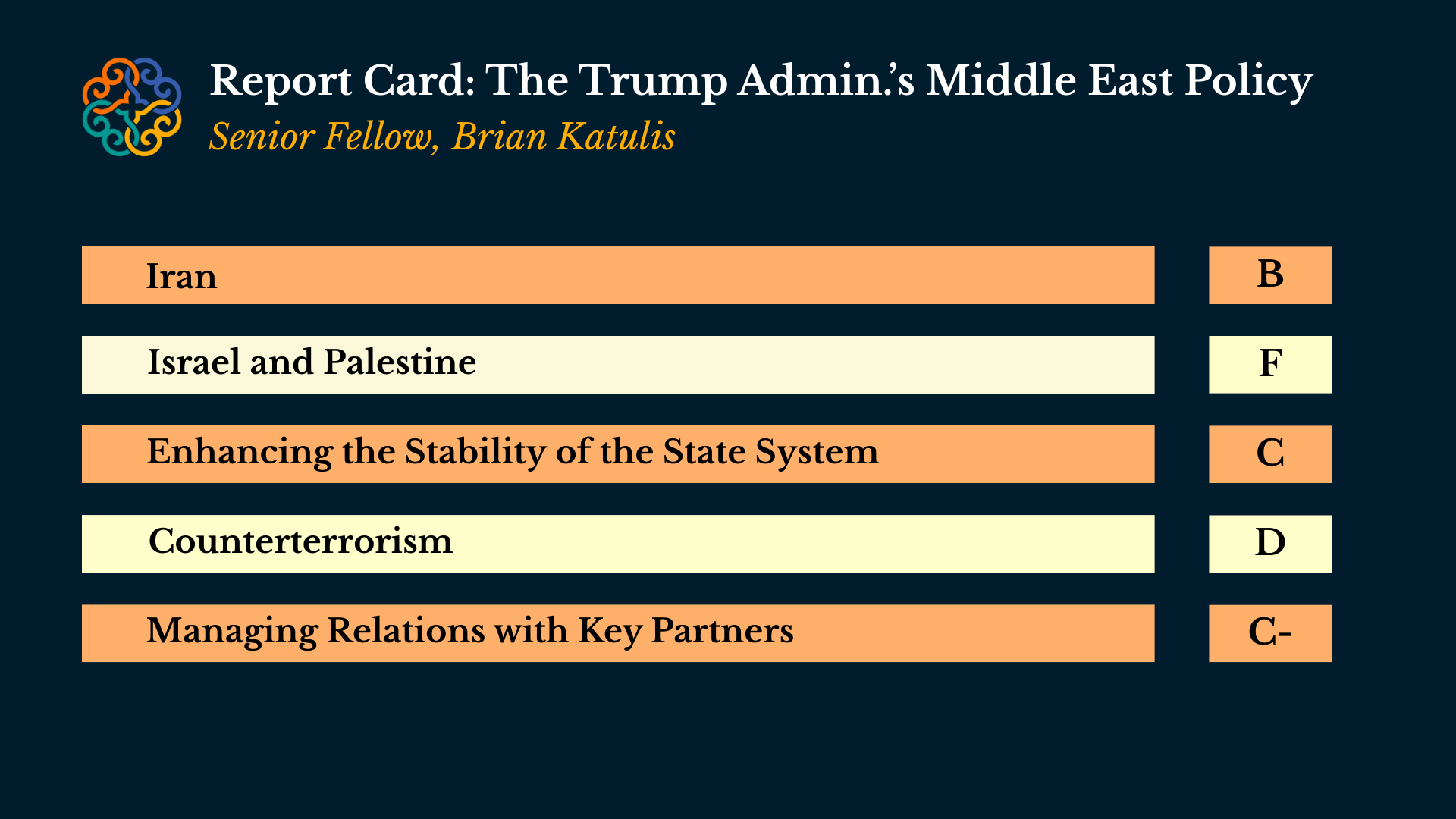
II. Trump 2.0’s Broader Foreign Policy Approach, January-April 2025
The second Trump administration’s Middle East approach is nested in a broader foreign policy playbook never deployed before by any previous US administration, including in the president’s first term. The first three months of Trump 2.0’s overall foreign policy approach has six main features:
1. Unilateral economic nationalism. Trump has set out to completely remake US economic relations with the rest of the world. The biggest headline from the first three months is the use or threat of tariffs and other policy tools to throw America’s economic weight around more to gain concessions and outcomes on other policy fronts, like immigration and the flow of illegal drugs. The main target of these efforts is China, America’s chief global rival and competitor.
2. The pursuit of quick diplomatic deals. The second Trump administration has prioritized quick diplomatic “wins” with long-time adversaries like Russia while disrupting and unsettling relationships with close partners in America’s immediate neighborhood as well as in Europe and Asia. It has sought to end Russia’s war against Ukraine using a range of disruptive and unexpected tactics. Just weeks into office the United States temporarily suspended military aid and intelligence cooperation with Ukraine, even as Russia continued its unprovoked assault on the country.
3. Skepticism of international, multilateral, and mini-lateral frameworks and an inclination toward a highly transactional selective bilateralism with certain partners. The Trump administration is strongly critical of international institutions like the United Nations and multilateral alliances such as the North Atlantic Treaty Organization (NATO), and some major questions loom about how Trump will engage with those organizations, as well as other long-standing regimes. The president has adopted instead a selective bilateralism that is highly personalized and transactional. A prime example of this was witnessed this spring in Trump’s bilateral meeting with El Salvadoran President Nayib Bukele, who has emerged as a willing supporter of the US president’s aggressive and harsh mass deportation policies. Trump’s national security template in his second term is to find partners who help him get results, even if the means used to achieve those outcomes break international norms and strain America’s democratic system at home.
4. Major cutbacks and overhaul of US institutions of diplomacy, strategic communications, and global economic development. The Trump administration came into office in January with an aggressive campaign to scale back and downgrade key tools of national power by gutting national security institutions. It effectively shuttered the US Agency for International Development (USAID) in a matter of weeks, and it moved to shut down institutions of US public diplomacy, including the Voice of America. Secretary of State Marco Rubio introduced plans for a major overhaul of US diplomatic institutions following the elimination of USAID. The Pentagon could see as many as 200,000 job cuts from a civilian workforce of 750,000 by Elon Musk’s Department of Government Efficiency. These efforts could very well amount to the unilateral disarmament of key US tools in diplomacy and economic development needed to shape the landscape and achieve desired outcomes.
5. Harsh immigration measures and plans for mass deportations. A top second-term agenda priority for the Trump administration is an unprecedented crackdown on immigration, in measures that affect America’s relations with many countries around the world.
6. Downgrading democracy and human rights in US foreign policy. Trump 2.0 has signaled in its aggressive efforts to dismantle key US institutions and its actions that raise concerns about the rule of law at home that US support for freedom, democracy, and human rights in its relations is no longer a priority.
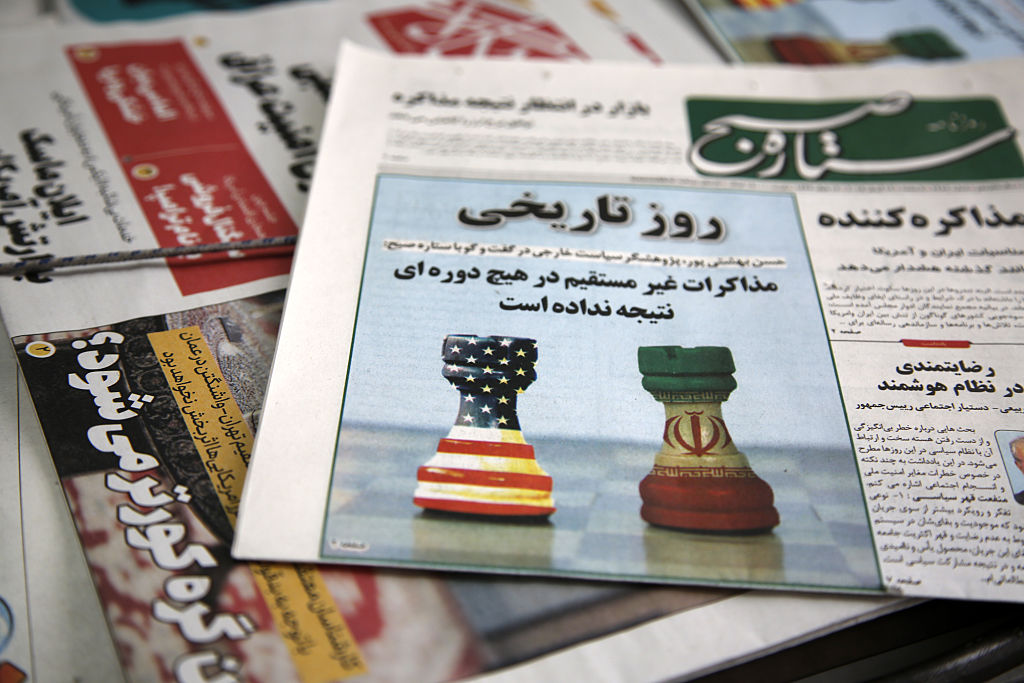
III. Trump 2.0’s Middle East Approach, January-April 2025
Iran
-
Overall Grade for US Policy: B
-
The second Trump administration has done a better-than-expected job in producing some signs of progress toward reaching a settlement with Iran on a new nuclear deal, with three rounds of talks leading to a fourth, but it remains unclear if the contours of the deal will address all key concerns about Iran.
-
The United States sent more ships and warplanes to the region as Trump threatened Iran with attack. The combination of credible military threats and warnings from the United States and Israel, along with key Arab partners advising Iran to take this moment seriously, may be helping to produce diplomatic momentum that the previous US administration was unable to achieve.
-
Key questions ahead include who will monitor and verify a potential deal, given the Trump administration’s distrust of the United Nations and other international institutions and continued plans to make massive cuts in America’s own foreign policy institutions, like the State Department and Central Intelligence Agency, which might be tasked with oversight. Also, voices concerned about the nature of the Iranian regime, including its destabilizing regional activities and actions against the Iranian people, worry that an incomplete deal will leave important strategic issues unresolved.
-
What to monitor: Watch the divisions within the Trump administration and gaps between the United States and its key partners in the region as events with Iran unfold. The Trump administration continues to send mixed messages about the contours of the deal that it might be willing to accept in diplomatic talks with Iran, including whether or not it would accept domestic uranium enrichment in Iran.
Israel and Palestine
-
Overall Grade for US Policy: F
-
The second Trump administration entered office with a cease-fire and hostage release deal in place that it helped secure with the Biden administration just before the latter left office in January 2025. Israel ended this latest pause in the fighting by launching strikes against Hamas targets in Gaza on March 18, and it also cut off all humanitarian aid to Gaza, a move aimed at pressuring Hamas to accept its demands.
-
In the last two months, the growing humanitarian crisis in the Gaza Strip and the stalled efforts to safely return hostages held by Hamas, including American captive Edan Alexander, remain the biggest challenges in the region that the Trump administration has yet to address successfully. The administration has remained engaged in efforts to achieve another cease-fire and even held direct talks with Hamas as part of ongoing regional diplomatic efforts.
-
Trump's impractical “Riviera of the Middle East” idea for the Gaza Strip was a distraction and mostly served to gain media attention, though some argue it may have motivated Arab countries to present their own alternative plan in early March — one that the Trump administration immediately rejected.
-
What to monitor: Watch whether the Trump team, working with regional interlocutors like Egypt and Qatar, can achieve another cease-fire and hostage release deal, and begin to map out a longer-term plan for post-conflict reconstruction in Gaza. Israel is poised to expand its military operations in the Gaza Strip in what Prime Minister Benjamin Netanyahu calls an “intensive” escalation and make moves that could undercut a lasting resolution of the Israeli-Palestinian conflict. Also monitor events in the West Bank, where violence and instability has increased and a weakened Palestinian Authority faces challenges to its political legitimacy.
Enhancing the Stability of the State System
-
Overall Grade for US Policy: C
-
Lebanon: A tenuous cease-fire. The Trump administration has engaged in ongoing diplomatic and security efforts to maintain the framework of the November 2024 Israel-Hezbollah cease-fire deal. That framework remains mostly in place, despite violations and limited instances of violence. Grade: B
-
Yemen: A stepped-up military campaign against the Houthis. In mid-March, the Trump administration initiated a military campaign against the Houthis in Yemen, one that has impacted the militant group’s operational capacity but has not yet fully restored security in the Red Sea or produced a pathway for long-term stability in the country. The costs of the US military campaign, which does not appear to be connected to a broader diplomatic or stabilization strategy, continue to mount. Yet the Houthis retain dangerous capacities to undermine regional stability, as seen in the group’s ballistic missile strike on Israel’s main airport on May 4. Two days later, on May 6, Trump announced that the US would stop strikes against the Houthis, even though it was unclear if the Houthis would commit to halting strikes against Red Sea shipping or regional countries such as Israel. Grade: D
-
Syria: Mostly hands off. The United States has not stayed deeply engaged in Syria’s transition and has started the process of withdrawing some US troops. US sanctions against Syria remain in place, which hinder efforts to facilitate economic reconstruction and engagement with the new government. Two top Republican and Democratic senators called for the lifting of sanctions in April. In March, loyalists of the former regime of Bashar al-Assad fought interim government forces in Alawite-majority towns in western Syria. The violence quickly took the lives of scores of civilians, with the reported death toll topping 1,000. Secretary Rubio released a statement on the escalation of violence, asserting that the United States “condemns the radical Islamist terrorists, including foreign jihadis, that murdered people in western Syria in recent days.” This Trump administration position on Syria reinforced a more-than-decade-long approach by the United States of making statements often not backed up by policy instruments to achieve the stated end goals. Grade: D
-
Iraq: Questions about a possible US troop withdrawal. The second Trump administration has not focused as much on Iraq as it has on Yemen and Lebanon, and many questions exist about the future of US engagement with Iraq as the country heads to its next national election this fall. Grade: Incomplete
-
What to monitor: Two key factors to watch are whether the United States stays engaged in Iraq and Syria with its military and diplomatic presence, and if the Trump administration can move beyond the “strikes without strategy” for countering Iran’s regional “Axis of Resistance.”
Counterterrorism
-
Overall Grade for US Policy: D
-
The Middle East continues to see persistent threats from terrorists groups like the Islamic State (ISIS) and al-Qaeda affiliates, including al-Qaeda in the Arabian Peninsula, as recent threat assessments by the US intelligence community and the Center for Strategic and International Studies have highlighted.
-
As with many components of the efforts on the “Axis of Resistance” elements, such as the military campaign against the Houthis, US counterterrorism in the region appears centered on tactical strikes against threats without an overarching strategy.
-
Simply conducting retaliatory or preventative one-off strikes and touting them aggressively over social media with press statements, as the Trump team did in Somalia earlier this year, is no real substitute for an actual counterterrorism approach that produces lasting stability. The terrorism problem in Somalia remains deeply worrisome, and no amount of public relations efforts will eliminate it without a comprehensive strategy that goes beyond sporadic bombs and missiles.
-
ISIS could see new openings and opportunities to expand depending on the decisions made in US policy on Syria and Iraq.
-
What to monitor: As with the efforts to enhance the stability of the regional state system, the US approach to counterterrorism is weakened by the Trump administration’s overreliance on military tactics and gutting of the other tools of US foreign policy needed to produce lasting results against the threats posed by terrorist networks. These tools include building stable diplomatic and military partnerships with key countries and groups aligned with the United States and investing in diplomatic, economic, and strategic communications mechanisms to counter and compete against terrorist groups.
Managing Relations with Key Partners
-
Overall Grade for US Policy: C-
-
The second Trump administration has prioritized relations with a select group of regional partners. Trump met with Israel’s Prime Minister Netanyahu twice and hosted Jordan’s King Abdullah, and his first scheduled foreign trip in his second term, to Saudi Arabia, the United Arab Emirates, and Qatar, is set for mid-May.
-
Trump 2.0 reinforced US military support for Israel and the current government’s actions, even as Israel lacks a clearly defined outcome for its policy in the longer term. The Trump administration started out its second term by authorizing the release of previously withheld 2,000-pound bombs, notifying Congress that it would sell around $7.4 billion in weapons to Israel. The moves indicate a shift in the direction of giving the current government in Israel even more unrestricted support than it had under the Biden administration.
-
The second Trump administration and President Trump have sent mixed messages to close partners like Jordan and Egypt, initially calling for these countries to accept millions of Palestinians from Gaza and threatening to cut US assistance if they did not. It also froze support to the Palestinian Authority security forces, a key partner in countering terrorism and instability in the West Bank.
-
At an Arab summit in Cairo on March 4, leading Arab countries reaffirmed their commitment to a two-state solution and presented a detailed plan for the recovery, reconstruction, and development of Gaza. The Trump administration’s first reaction was to reject this plan, saying that it was unrealistic and did not deal sufficiently with the question of Hamas, the Palestinian terrorist group and political movement that started this latest war and still controls key parts of the Gaza Strip. The lack of meaningful progress on the Israeli-Palestinian front will limit the prospects for a major advance that President Trump is hoping for in forging an Israeli-Saudi normalization accord.
-
The Trump administration prioritizes economic and energy ties with key partners in the Middle East. It has secured commitments from regional economic powers like Saudi Arabia and the UAE to make hundreds of billions of dollars of investments in the United States. For example, Saudi Arabia shared plans with Trump to invest more than $600 billion in the United States over the next four years. Energy is a key part of America’s economic relations with many Middle East countries, and America’s energy policy was one of the top priorities in Trump’s initial flurry of executive orders, with a stronger focus on fossil fuels and a shift away from green energy.
-
What to monitor: A wildcard to watch for is what effect Trump’s global economic policies, including his stepped-up trade wars, might have on relations with key Middle East partners on economic, technology, and energy policy as they seek to navigate increased US policy uncertainty.
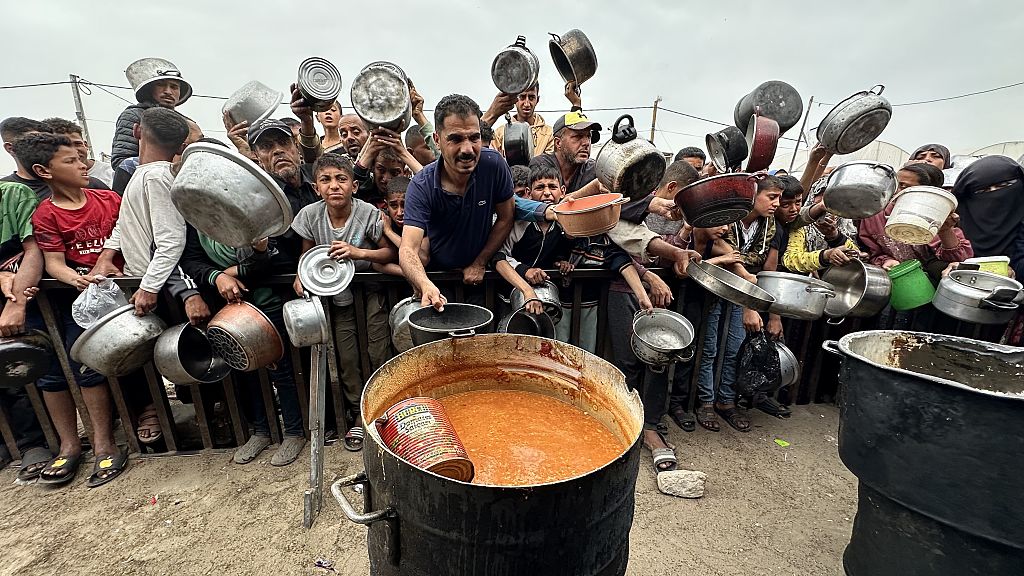
IV. Key Analytic Judgments
-
Maximum uncertainty in today’s Middle East. Regional uncertainty remains high as assertive countries and non-state actors in the Middle East adjust to the most unpredictable and unconventional US president in America’s history.
-
Increased incentives for subtle hedging. Key US partners in the Middle East are likely to continue working closely with the United States even as they diversify their global relationships to hedge against policy uncertainty and political risk from America.
-
Risks of deals on the cheap. The US drive to produce “quick wins” in diplomacy in arms control deals like the Iran talks and peace settlements may result in fragile agreements. Deals that are more likely to stand the test of time are ones that reflect the balance of forces and interests of the parties, and these agreements are usually the product of intensive diplomacy that builds trust and confidence among all parties to the negotiation.
-
Unilateral disarmament of key US powers. The moves to cut and gut long-standing US institutions essential in the diplomatic, economic, political, and strategic communications toolkit will produce incentives for America’s adversaries like Iran and competitors like China to fill the vacuum. But it may motivate some US partners with sufficient resources and capacities to fill gaps left behind.
-
Great risk of “group think” in the second Trump administration. The management style of President Trump and the appointment of top officials have placed a higher premium on loyalty over other attributes, increasing the risk of “group think” and blind spots in US policymaking.
V. Conclusion
The Trump administration began its second term in office prioritizing the Middle East in part because events such as the devastating conflict between Israel and Hamas in Gaza forced it to do so, but it also sees some potential in achieving progress toward a nuclear deal with Iran and normalization between Israel and Saudi Arabia. The Middle East remains a key arena for geopolitical competition, and the fact that President Trump is making his first scheduled overseas trip in his second term to the Middle East sends a message that he is prioritizing the region.
Trump’s opening months in office included a gambit to smooth ties with Russia and step up competition with China, but both countries have their own approaches and relationships with the Middle East, and the interlinkage between the wider geopolitical landscape and dynamics in the region must be managed in a coordinated and coherent way.
The Trump administration has thus far constructed an approach in the Middle East that will likely prevent it from building the widest possible regional coalition to address both the Israeli-Palestinian issue and Iran. Such an approach risks weakening rather than strengthening America’s position in the region and the world. The unilateral, zero-sum approach risks missing opportunities to get regional partners to pull their own weight in collective action efforts to address regional and global challenges.
Brian Katulis is a Senior Fellow at the Middle East Institute.
Top photo credit: Andrew Harnik/Getty Images
Acknowledgments
This report represents the independent analytical judgments of one scholar, based on his policy research and feedback from colleagues and peers, with essential research support from Athena Masthoff, Luke Zakedis, and Sharif Mani.
The author would like to thank colleagues and peers who took time to review a draft of this report and offer comments, including Kenneth Pollack, Intissar Fakir, Charles Lister, Susan Saxton, Alistair Taylor, Matthew Czekaj, Alex Vatanka, Marvin G. Weinbaum, Dan Benaim, Iulia Joja, Eryn Gold, Hamad Alshamlan, and Cayla Bernstein.






